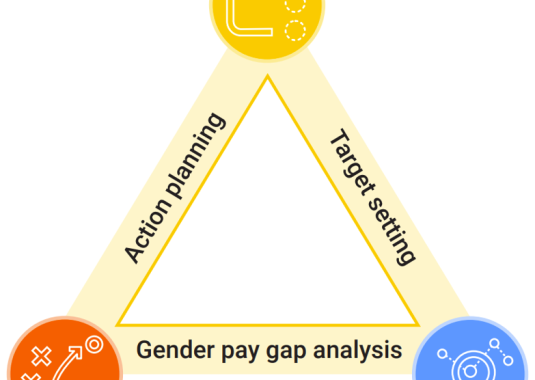Ready to take action to improve gender equality in your workplace? Need a bit of support and guidance along the way? WGEA's Take Action Employer Guides are free to download. And if you need more support, you can book in a Capacity Building Masterclass or 1:1 support.
Our most popular employer guides
WGEA's gender equality strategy tools and guides can help you to determine where to focus your efforts as you plan policies and strategies to improving workplace gender equality.
The WGEA Gender Pay Gap Analysis guide details the data you need and what to look for as you search for hotspots of inequality in your workplace composition and remuneration data.
The Action Planning Tool helps employers who report to WGEA identify actions they can take to improve gender equality in their workplace.
You've found your hotspots of inequality. Now what can you do to improve? WGEA's Action Planning Playbook offers a framework to help you prioritise evidence-based actions to improve gender equality. Even better, it describes why each action works.
Employers can provide a link to an Employer Statement to sit alongside their gender pay gaps on Data Explorer. Our Employer Statement Guide explains how you can use this Statement to provide context and drive action.
Looking to improve your parental leave policy, flexible work, recruitment or governing body selection policies? WGEA's gender equal policy and strategy guides offer help to deepen your workplace policies and improve gender equality.
Do you need to make a business case for promoting or improving gender equality in your workplace? WGEA's Gender Equal Business Case Gude can help you with the key details to include.
WGEA's gender strategy guide shows you how to analyse, design, implement and review changes that will improve workplace gender equality.
WGEA's Gender Equality diagnostic tool will help you pinpoint equality gaps in your organisation.
This guide provides context, practical insights, and questions for boards and directors.
Employer gender pay gaps
Keen to take action to reduce your gender pay gap? The first step you need to take is to measure it so you can understand what's causing it. These tools and guides will set you up for success.
The WGEA Gender Pay Gap Analysis Guide helps employers to plan and execute a pay and composition analysis in order to identify the drivers of their gender pay gap.
WGEA has a series of live masterclasses and live learning events to guide employers to deepen understanding of workplace gender equality take action to narrow organisations’ gender pay gaps.
Employers have the opportunity to provide a Statement that gives context to their gender pay gap results when WGEA publishes employer gender pay gaps in early 2024.
Find out how WGEA calculates and presents its employer gender pay gap data
Gender pay gaps can still occur when wages are set by awards and agreements. Find out why this happens, how you can find the causes and how you can take action to address them.
WGEA's 3-step pay equity guide will help small businesses address pay equity issues.
Workforce composition
Workforce composition includes participation rates of employees in full-time, part-time, and casual work as well as the proportion of women and men in leadership roles and salary ranges. Employers can address issues around recruitment and promotion to improve gender equality.
Use this guide to help identify and remove gender bias from interviews, selection criteria, employee feedback and 'merit' promotion.
Increasing the number of women in leadership reduces the gender pay gap, improves profitability and productivity.
Research shows women face a backlash negotiating salary and men face a backlash for negotiating flexible work.
Need help to prove that gender bias in recruitment and promotion exists? This page runs through all the research and studies.
Evidence-based insights from Australian companies on how to dismantle barriers to women's participation at senior levels.
Find out the difference between mentoring and sponsorship and how you can apply these strategies to improve gender equality.
Flexible work
Flexible work can take many forms including reduced hours, job-sharing, working from home, compressed working weeks, unpaid leave and flexible hours. Find out how you can make flexible work benefit you and your employees equally.
WGEA's flexible work guide details best practice for employers and includes a diagnostic tool to check how your organisation is performing.
WGEA's flexible work checklist helps employers support and maintain a quality flexible working environment.
WGEA has created this guide to help employers advance paid parental leave and flexibility arrangements in the workplace.
WGEA’s GEI Policy and Strategy Guides help employers to craft a policy or strategy for each of the 6 Gender Equality Indicators, including employment conditions relating to flexible work.
Parental leave and support for carers
Addressing gendered barriers to parental leave and support for carers can have a significant effect on workplace gender equality.
Find out how supporting carers in your workplace can have positive impacts for your business.
WGEA's parental leave hub has information on leading practice, case studies and guides for gender equitable approaches.
How to build a business case, implement and review a parental leave policy.
Men make up 42% of all parental leave taken at John Holland. Find out how, and why, they did it.
How Stockland improved return to work rates by 20% and employee engagement by changing its parental leave policy.
Employee consultation
Employers that consult employees on gender equality issues can ensure their policies will create meaningful change.
Surveys, focus groups, workshops and committees are just some of the methods employers can use to consult employees. Find out the pros and cons of each in our guide to consulting employees on gender equality.
Harm prevention
Employers have a responsibility to prevent sexual harassment and discrimination on the ground of sex in their workplace. Find out how you can take action today.
Using evidence to improve workplace sexual harassment prevention and response: The Employer Guide will help you meet your obligations under Positive Duty.
How to tackle and eliminate these issues in the workplace.
Resources to help implement family violence policies and support.

